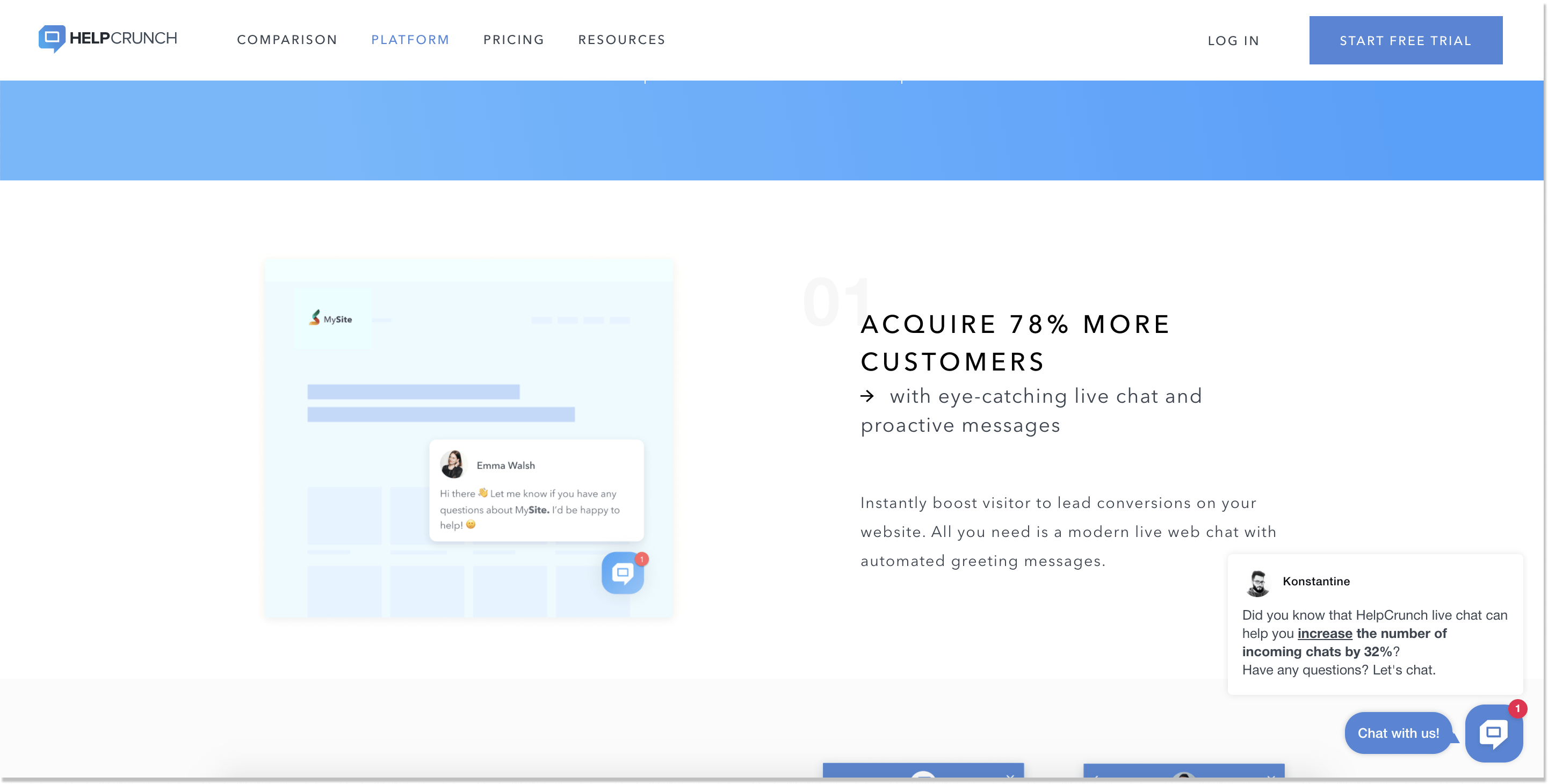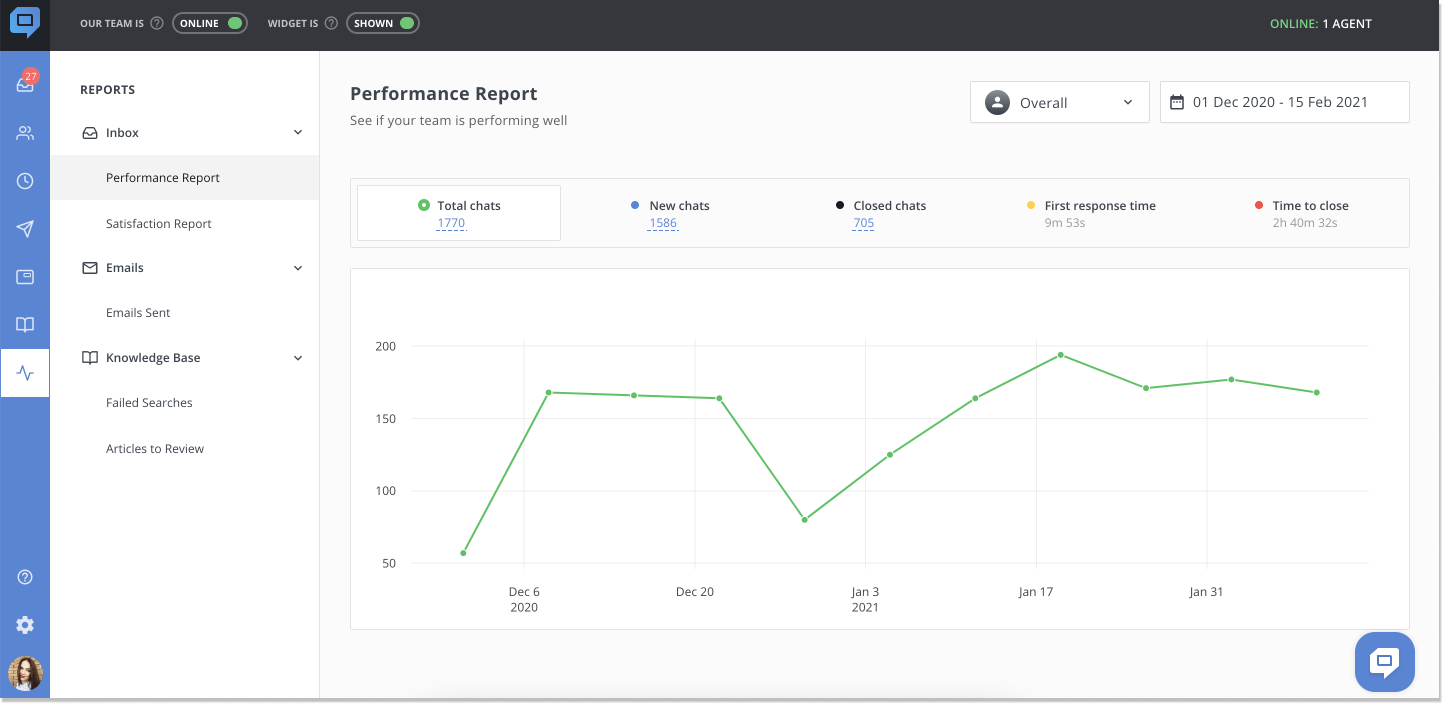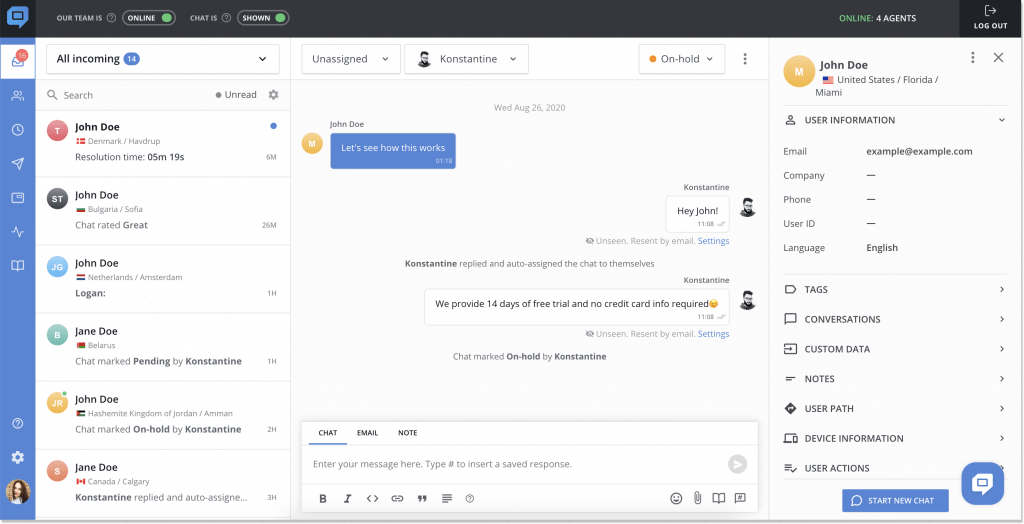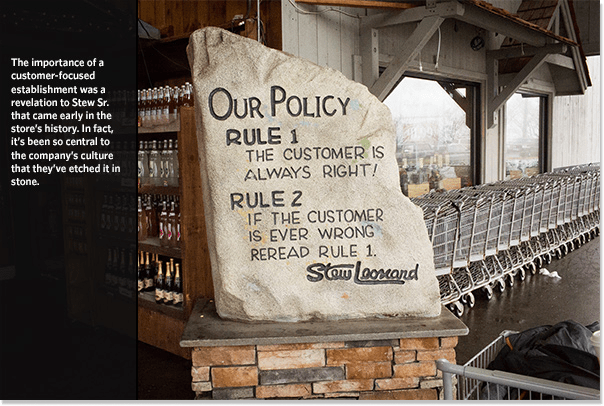15 Tried and Tested Customer Service Rules to Boost Satisfaction
Learn how these 15 golden customer service rules can help improve your team performance and make customers happier.
Written by Daniil Kopilevych

Everything has its own regulations. Learn how these 15 golden customer service rules can help improve your team performance, make customers happier, and fine-tune customer support.
You can only do the best customer service when you step into your clients’ shoes. However, the shoe size may be slightly different. So, your behavior in various situations may also vary.
A client should not feel any difference whether they are talking to Robert, Diane, or Alex because the level of assistance is always the same.
There is only one way to reach that uniform quality level that clients are happy with, and that’s setting the rules.
By introducing certain customer service guidelines your team should follow in their communications with clients, you can be sure that the staff shows the same high level of service.
To help you get started, we are going to share the golden rules of exceptional customer service. Hopefully, our recommendations will assist you in building the greatest experiences. In addition, we included examples from five major brands and their practices. Let’s see if they have anything worth adopting.
10 rules for stellar customer service
This guide has nothing in common with such generic phrases as “Be polite“, “Don’t stress“, or “Remember: the customer is king“. Seriously, though, they are all relics of the past. We have other up-to-date tips up our sleeve. Have your notebooks ready, let’s put together the golden rules for great customer service.
1. Practice a prompt response
You don’t like being put on hold and listening to boring music, do you? Do you hate it when your emails seem to sink into a black hole with no answer for hours? Well, that’s the customer’s shoes for you. They don’t like it either.
Forrester found that as many as 73% of people appreciate it when the company values their time.
Now, how fast is “fast”? Let’s break it down into different communication channels. On average, companies take about 12 hours to respond to an email, which falls well within the customer expectations – the majority expect their emails to be answered within 24 hours.
In a live chat, however, customers expect an immediate response. That’s a challenge but also a great advantage of using this communication channel in your services.
Coupled with other live chat benefits, there is the fastest response time as compared to other channels – 2 minutes – and that, in turn, increases the customer satisfaction rate.

2. Exceed expectations with proactive service
This is a logical follow-up to the previous point in our list of rules of customer service excellence. Adopting a proactive approach means anticipating the problem before it turns into one, as opposed to being reactive, which is handling the problem that already exists.
In terms of the best assistance, becoming proactive is a multi-sided task that will bring huge benefits at the end of the day. It involves such activities:
- Asking for customer feedback
- Monitoring social media and other resources for comments
- Creating a knowledge base
- Recognizing your mistakes and informing people about them
Showing your initiative is the future of customer support. Your sincere willingness to make a bit of extra effort and lend a helping hand to a client ASAP can result in a positive experience. In turn, positive experiences increase loyalty and turn customers into your best brand advocates.
One of the techniques here is the use of auto messages sent at the right time following a certain predefined activity by the user. Such messages initiate conversations with users and ultimately increase the conversion rate.

3. Treat your service reps as customers
This is one of the ground rules of good customer service. Happy employees equal happy customers. When your team members feel valued and respected, they will carry that attitude further into their daily interactions.
Let’s admit, the job of a customer service representative is full of stress and negative emotions. Positive reviews are great, but clients rarely contact support to say how satisfied they are with the services. Instead, this position gets most of the customers’ frustration and anger.
Make the job of your support team convenient and effective. For example, start with organizing an ergonomic working space and providing them access to user-friendly customer service tools of your team’s choice.
By treating your staff as you treat your clients – with respect and dignity – you are building a great team of highly motivated people you can always rely on.
4. Encourage everyone to the company’s matters
In a client-facing business, all activities ultimately boil down to making the customers happy. No matter how distant your position may be from the actual help desk department, you are a part of it, too, even if indirectly.
Jan Carlzon, a former CEO of SAS Group, once said: “If you’re not serving the customer, your job is to be serving someone who is.” This is a great description of how things should work in a truly successful company.
The practical aspect of this concept is that a company should aim at the level where every employee, from CEO to warehouse staff, should be able to help resolve customer inquiries. This is what customer service orientation looks like.
Such cases are quite frequent in small businesses. We have all seen how restaurant owners dress in waiter’s uniforms and wait on tables on busy nights or startup founders answering customer questions via chat at 2 AM.
For example, take a look at Richard Branson, the Virgin Group chairman, wearing a flight attendant uniform. It suits him, don’t you think? Such an experiment indicates two things: 1) he isn’t afraid of any challenge, and 2) he is the example of a person who thinks customer service is everyone’s job.

Even if you can’t help a client directly, point them to the one who can or, preferably, find the solution on your own without bouncing them between departments.
5. Use customer service as a satisfaction driver
This point may throw a little light on the “Why is customer service important?” question. In fact, it is a key component of customer success that is becoming a major growth driver.
We live in a world where competition in all sectors is truly insane. Today, businesses are focusing on the client and striving to help them achieve the most successful experience of their products.
On the one hand, this means that brands begin investing more in their help desk departments. On the other hand, they’re turning them into a proactive force exploring opportunities rather than solving problems.
Instead of simply fixing the client’s issue, the service rep should use this chance to sound out how they are generally satisfied with the product and try to raise that satisfaction level, if possible.
The rules for good customer service usually involve showing new options, offering related products, or helping with client onboarding – you know what I am talking about.
6. Sound rather informal
It is up to you to choose the communication style – some businesses are formal while others prefer a more relaxed attitude. However, there is a hard fact to consider: 65% of clients prefer a casual tone to a formal one.
Why is that? A formal or even neutral tone may sound distant or indifferent to the customer as they expect empathy and care.
However, do not overuse a rather informal tone. In the worst-case scenario, it may create an impression you don’t take the client’s problem seriously.
Be also careful with LOLs (laughing out loud) or BRBs (be right back). While they are perfectly OK in personal conversations, for a rep using such lingo is highly unprofessional. Though feel free to add a pinch of humor (it won’t hurt).
In a nutshell, clients expect service agents to be human in the first place. Even in today’s age of advanced technologies and artificial intelligence, 74% of customers still want to interact with humans. Thus, try to be caring and emphatic while remaining professional and respectful.
7. Improve customer service skills
Don’t forget about honing your team’s customer service skills. They include everything from empathy, stress management, and a desire to improve computer skills and language proficiency.
Besides, you can always teach your reps to learn and practice the art of support. Trust me, both your newbie colleagues and seasoned gurus will benefit from them.
Your team should be well aware of your product, services, or website. They must be the first to know about such stuff as:
- Updates
- New releases
- Patches
- Product-related events
- Promotion campaigns
There’s always self-education. The industry has been around long enough to accumulate quite a wealth of wisdom. You can find lots of really great books on good customer service. Start, for example, with:
- Win the Customer: 70 Simple Rules for Sensational Service by Flavio Martins
- The 10 Golden Rules of Customer Service: The Story of the $6,000 Egg (Ignite Reads) by Todd and Deb Duncan
- Amaze Every Customer Every Time: 52 Tools for Delivering the Most Amazing Customer Service on the Planet by Shep Hyken
8. Go the extra mile
Don’t ever promise more than you can deliver, but always deliver more than you promise. Though this quote belongs to an American football coach Lou Holtz, it fits customer services like hand and glove. The reason is simple.
When we make promises, we enter the territory of trust. It is a precious thing that takes months and years to build but can be destroyed in a snap. In a client-facing business, trust leads to customer loyalty and retention, brand advocacy, higher conversion rates, and everything else marketing experts get paid for.
Any promise that a team makes must be based on solid knowledge and confidence it can be fulfilled. Sure, it is nice to assure a client you can do what they ask for, but some things are just impossible. That’s a fact, and we have to live with it. Promising something that has little chance of being delivered can kill trust.
On the other hand, promising the moon can win points for you. If your client is complaining about their Internet failure, say you will fix everything as in the standard repair window, even if you know that the team is already working and may finish sooner. If they get their Internet back in 2 hours instead of 8, that may be the factor that turns a failure into an opportunity and brings you more satisfied customers.
9. Monitor team performance
No, this is not about punching a time clock and controlling when people come and go. Today, you can gather tons of different customer service KPIs and metrics that evaluate the effectiveness and find faults or bottlenecks in your staff’s workflow.
With a properly configured reporting system, you will be able to monitor the number of calls or requests your team receives, the time taken to respond or resolve the issue, the number of replies in each interaction, and a lot more. Reports help to see whether the problem persists over time or is seasonal or otherwise repetitive.
For instance, HelpCrunch includes a comprehensive reporting section displaying all sorts of metrics that you can use to track and improve your team’s performance. Here, you can easily check how your staff is performing, whether clients are pleased, or if there are any knowledge base articles to improve. Monitoring the customer service performance on a regular basis provides lots of valuable insights for further refinement.

10. The most important rule: Adopt all-in-one customer support tools
Why spread yourself too thin to a gazillion providers that give you an additional problem of integrating and maintaining the tools? Let alone, training your personnel to have different UIs, controls, flows, and troubleshooting principles.
I have a better suggestion. If you’re looking for a feature-packed live chat, an integrated knowledge base, an intuitive dashboard, and email automation, you’d better find an all-in-one solution.
HelpCrunch and its user-facing functionality, a convenient dashboard to manage all interactions, a help desk, and a reporting suite may be just the thing. In a word, there is everything you need to create win-win experiences in just one platform.

5 customer service guidelines examples
Now that you’re armed with knowledge, it’s time to see the customer service standards that other businesses practice. Here is a short summary of the rules for excellent customer service adopted by major global brands that need no introduction.
1. Apple’s policy
Apple’s policy is based on – surprise! – APPLE. Or, rather, A.P.P.L.E. This acronym is the core of its rules of customer service:
- A – Approach clients with a personalized, warm welcome
- P – Probe politely to understand all the customer’s needs
- P – Present a solution for the client to take home today
- L – Listen for and resolve any issues or concerns
- E – End with a fond farewell and an invitation to return
Self-evident, isn’t it? Judging from Apple’s steady upward climb both in popularity and in market capitalization charts, this approach works just fine.
2. Disney’s affirmation
Being an entertainment company, Disney stands out from among other names on our list. Delivering happiness, joy, and fun is a challenge in itself. The company sets the rules of customer service for employees in its amusement parks as well as for those handling claims and complaints (by the way, it looks like an affirmation):
- I project a positive image and energy
- I stay in character and play my part
- I am courteous and respectful to all guests including children
- I go above and beyond
However, for situations where clients are somehow unhappy with the assistance and leave a somewhat negative review, Disney applies the LAST model:
- Listen
- Apologize
- Solve
- Thank
Nothing fancy, as you can see, but it works. Everyone wants to be listened to and treated with dignity.
3. Ritz-Carlton’s Gold Standards
When you browse the Ritz-Carlton Gold Standards page, every word spells luxury and class. This hotel chain steadily tops various customer service ratings, and its values played no small part in it.
Ritz-Carlton focuses both on its clients and employees, making the former satisfied with a highly personalized experience and the latter proud of being a part of this business. The motto alone gives an idea of the high standards that the hotel chain sets: “We are Ladies and Gentlemen serving Ladies and Gentlemen”.
The rules of customer service that Ritz-Carlton uses are also high-class. We have picked some of the most significant ones:
- I build strong relationships and create Ritz-Carlton guests for life
- I am always responsive to the expressed and unexpressed wishes and needs of our guests
- I continuously seek opportunities to innovate and improve The Ritz-Carlton experience
- I own and immediately resolve guest problems
- I am proud of my professional appearance, language, and behavior
4. Richard Branson’s rules for customer service
We know Sir Richard Branson as an entrepreneur, philanthropist, and an eccentric and cheerful person. However, mainly, we know him as the founder of Virgin Group which includes Virgin Atlantic, an airline often receiving praise from passengers for the service quality.
Richard Branson has worked out 7 basic policies that he uses to achieve the best customer service as the company leader:
- Be visible
- Express a passionate commitment to serving the customer
- Your company’s employees are its greatest assets
- Hire people who have the Virgin attitude
- Empower your employees to solve problems and to make every experience great
- Engage in social media with a genuine voice
- Have fun
5. Stew Leonard’s simplicity
Stew Leonard’s, a supermarket chain, has a ridiculously simple set of customer service rules. In fact, there are only two of them, and they are literally carved on a stone. The stone in question is a three-ton block of granite bearing these two simple regulations:
- Rule 1: The customer is always right!
- Rule 2: If the customer is ever wrong, reread Rule 1!
We’ll leave it to you to decide whether to adopt the same policy in your business, but, admit it, there is something to it.

Final words
Undoubtedly, all the above-mentioned don’t form one basic pillar of a unique customer service philosophy. There is no bottom line alike. Everything is up to you and your wish to be recognizable among other competitors. Another thing that makes a world of difference is effective software.The answer is in the air. All you have to do is create a free account with HelpCrunch – a 14-day trial with no credit card required – and provide a whole new level of assistance to your clients!





